Text
To Stockholm
4/10/2019: We got up early this morning to a six thirty alarm. Shane slept a bit longer until Jo told him to get up. It was pretty cool. Just under eight degrees all morning. No sign of the Atlantic storms coming through yet.
A cup of tea only, load and turn on the dish washer. Jo took the rubbish and recyclables to the bins down stairs. Shane took the bottles to the glass dispenser on the corner. We were out of the apartment by eight thirty, the train left at ten twenty three and we wanted plenty of time to spare as it was unfamiliar territory.
We followed the street to the museum and turned right into Stormgade. Planning to stay on the same side all the way proved difficult with couple of obstacles in the way, a scaffold on the left hand side narrowed the footpath making dragging suitcases difficult, particularly as Shane's bag had a blowout and only had three wheels operating. Only one of the two on the drag side. He blamed the cobblestones
although Jo's suitcase on all four wheels survived. You work out what the cause for his broken wheels was 101. Crossing to the right hand side avoided the scaffold but upon reaching the Tivoli, the footpath was blocked by more construction works, forcing pedestrians, bicycles and cars turning right into the same area. We noticed the problem a couple of days earlier when returning from Helsingør so at the intersection prior, we changed sides again.

Dragging the bags was a struggle but we got there
We arrived at København H well before time but just made it, suitcase hanging on. At the other end of the station, next to the Politi, was a little café with vacant seats outside. This was the resting place for a pastry and cuppa until Shane asked for advice about the train from an information woman and was told with first class DSB tickets we were entitled to sit in the DSB Lounge, which we did. A lot more comfortable than on the concourse. We enquired about where the train was leaving from and was told to wait for it to come on the screen. All S Train platforms, one to twelve was accessible from where we were sitting but platform twenty six was different. It was fifteen minutes away so the assistant in the lounge said that if platform twenty six came up, we would need to leave the lounge by ten. Not long after the conversation, platform twenty six came up. Off we went dragging our bags back out of the station, down the street to the lights and down onto the platform which started where all of the other platforms ended. To make things worse, another wheel on Shane's suitcase had given up the ghost.
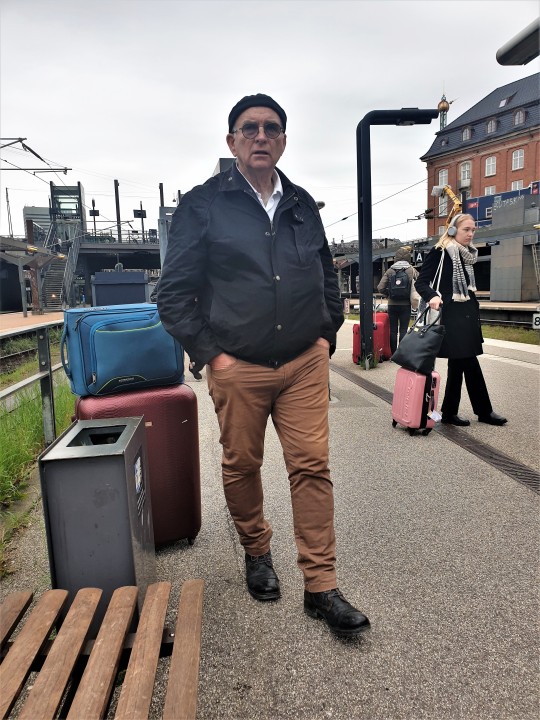
On Platform 26
We were in Vagn 1 so had to hang around platform sections one to three. This suggested to us that we were in the first carriage and choosing forward facing seats, we would get a good view of the Øresund Bridge as we went over it. No such luck as after we had settled in our seats, the train departed the way it came. We were in the last carriage and facing backwards.
Jo point this out to Shane when they were selecting the tickets online all those months ago but just as he swore he knew the way to the station two days ago (we had walked more than the expected kilometre to the station and discovered we were a kilometre away in the opposite direction before he admitted defeat). Another cockup as Cecilia would say. It didn't matter in the end though. The train travelled under the bridge and the approaches were deep with high retaining walls obscuring any possibility of a view.
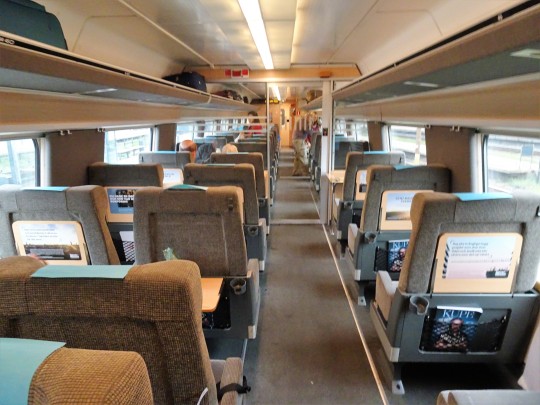
First Class in the S Train. Very comfortable
At the first or second station the conductor come butler changed over. From an old bloke to a young bloke. The first thing that he done was approach us to confirm what we had already told the other dude. Around twelve for our pre ordered lunch. Not long afterward he brought the menu, in Swedish but translated it the best he could. We had trouble understanding him when he was pointing out what we thought were the meal choices. It was pork, turkey and desert. He was actually telling us the entire menu was what we would get. By very close to twelve we were served, airline style pork pate, turkey slices with a nice rice concoction and a chocolate brownie along with soda water flavoured with lemon. The bread was like a large cracker. Pretty good feed all round. There was still nearly three hours to go. Several stations were stopping points but not many. It was effectively a through train. We also found that not too much scenery was to be enjoyed as the place was quite bland, from the rail perspective anyway.
We arrived at Stockholm Central before four, grabbed a cab and gave him the address. He was okay with taking us but looked a little puzzled. Turned out that he wasn't familiar with the old city and the streets, one wayers and skinny lanes. We got there though and only fifty bucks for a couple of kilometre journey. Bumper to bumper all the way. He ended up turning into Norra Bankogränd and right into Österlånggatan, veering left up the ramp off Södra Benickebrinken and dropped us off at the corner of our street, Baggensgatan. In his broken English he said he wasn't keen to go up the narrow street as he may have had trouble getting out. We dragged the suitcases up to Residence Perseus, tapped in the apartment code and let ourselves in. Not long after we headed down to the bottom foyer and the entrance onto Österlånggatan. Watch your step, it was quite a last step to the street. We were on the island of Gamla Stan, the city’s old town.
Following Österlånggatan south for a while, taking our time to window shop, we ended up at Järntorget or Iron Square where we veered to the right into Västerlånggatan. Plenty of shops and restaurants here.

Just off Västerlånggatan was Mårten Trotzigs Gränd, an alley named after merchant and burgher Mårten Trotzig. Mårten was a German who was born in 1559 and settled in Stockholm in 1581. He bought properties in the alley in around the turn of the seventeenth century and had a business there
Having walked around the street for a while looking for souvenirs we were also eyeing off somewhere for a feed. Some interesting restaurants were around. One restaurant that came to our attention was a themed Viking restaurant called Aifur Krug. It looked interesting, drawing us down the steps and inside. When we asked if they had any room they said no, booked out. The place was packed so we squeezed over into a corner to have a beer served in what you could only describe as clay pots. Great atmosphere. We booked in for dinner on the last night in Stockholm.

Aifur Restaurant

Drinks menu
The joint next door was our next choice for dinner. Ardbeg Embassy was an interesting concept, Viking food with Scottish whiskey. It was pretty popular though. Ordering some interesting and tasty local dishes, we were not disappointed. Herrings and reindeer for Shane, fennel soup and beef for Jo. Plenty of food and a couple of whiskies finished off the night.

Old mate serving shots of Argberg whisky straight from the barrel
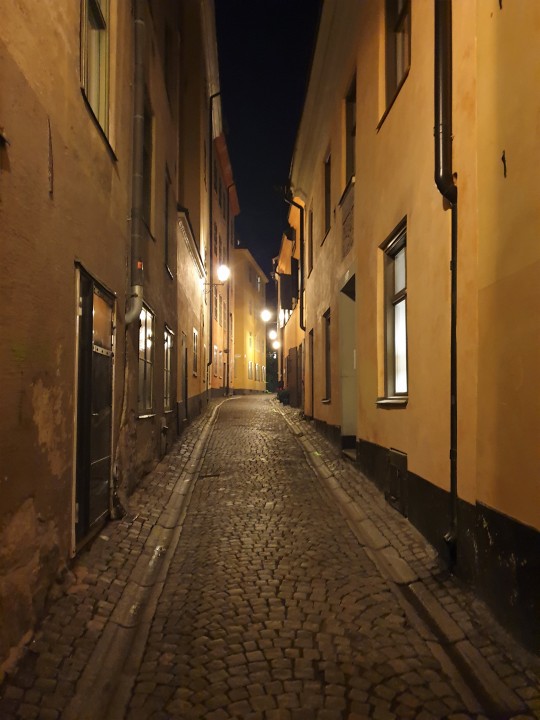
Up the hill to our apartment
Apart from the fifty Euros for the cab ride, it was a great day. Tomorrow we'll do some museums.
1 note
·
View note
Text
Rosenborg
3/10/2019: It's the last full day in Copenhagen today. We slept in with no alarm and had toast, salami, tea and juice for breakfast. We didn't leave the apartment until well after eleven and headed up Nytorv, trying to keep out the way of the bicycles and into the pedestrian friendly mall, Nygade. This time we turned right when we should have turned right. Lego was a couple of blocks down, on the corner with the junction of Hyskenstræde and Klosterstræde, straight across from Zara.
This store had some good but expensive stuff, London Bridge, life size R2D2 and stormtroopers, scale model of Nyhavn. Very impressive but somewhat overpriced. We looked around, bought some trinkets and moved on. One disappointing thing that we found was naked women posters on the power boxes out the front of the store in full view of the kids as they went in.

Something about Ekko by Aksel Hansen
Rosenborg Castle came about after the ascension to the throne of Christian IV when he formed the view that his castle of the time, Copenhagen Castle had outlived its welcome. In 1606 the king bought forty lots outside of the Nørrevold wall where he would build his new residence, Rosenborg. Going through four iterations of development, what you see now was completed in 1633.
Used as a royal residence until 1710, Frederik IV was more akin to more modern residences and as such dedicated the palace to the royal collections and moved on. The original royal collection consisted of Christian IV’s riding trappings and parade arms transferred from Frederiksborg in 1658, followed by his costumes, then heirlooms and precious artefacts. The Regalia were transferred to Rosenborg from Copenhagen Castle during Christian V’s reign. During the reign of Frederik IV, the collection of glass and porcelain arrived as well as the art collections belonging to the Dukes of Schleswig-Holstein-Gottorp, ceded to him during the Great Northern War. In 1838 the castle was opened to the public and following the abolishment of Absolutism in 1849, the royal castles and palaces became property of the state. Within five years Frederik VII agreed with the state that the collection was to become entailed property passed on from king to king.

One of the makers of the famous clock in Strasbourg Cathedral made this in 1594. The astronomical clock has a carillon to play music and moving figures. It shows days, months and years as well as lunar phases, an hour hand for both twelve and twenty four hour clocks but no minute hand as technology was not that advanced. The introduction of the pendulum sorted that out.
A room to the side of the Winter Room was Christian IV's Writing Room where the king carried out his correspondence. Again, covered in paintings, this room was largely original. At some point Christian installed a staircase for direct access to the basement. Frederik III was a bit lazier and pulled the staircase out, replacing it with an ascenseur, ascending chair. This linked the first and second floors.

On his death bed 1648. Apparently he loved the place so much that when he knew he was on his last legs at Frederiksborg, he commanded that he be dragged to Rosenborg by sleigh so he could drop off the perch there
Then to the Royal bog. Formerly known as "The Secret", it was one of three which conveniently dropped all of their contents into the moat. Each had a water cistern for flushing but when the moat was dry or low, they used to pong. Somewhat original but redecorated over time by his descendants.
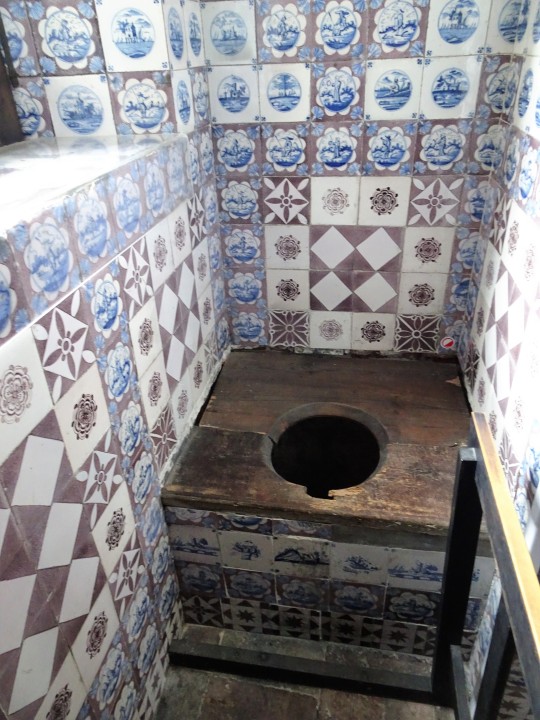
The Royal Bog
The next room was the Dark Room, which was also a bit eerie. Once used as a common bedroom for Frederik IV and his missus, the room now contained wax busts of Frederik III, Queen Sophie Amalie and their son Prince George. Contained within glass cabinets gave the feel of what you'd expect in an archaic penny arcade. The room also contained some interesting furniture. The adjacent room was the garden room which actually had windows and was a lot brighter.

Frederik III must have been a bit of a prankster, his Trouser Watering Chair was designed to trap a guest in the chair after sitting in it by wire prongs hidden in the armrests curling around their arms and holding them down. Then water would be released from containers in the backrest down into the seat cushion, giving the impression that the guest had pissed themselves. Good one Frederik. Once the victim was released and stood up, a trumpet hidden in the seat wood toot.
The next room was the Marble Room decorated in a pompous Baroque style to celebrate Absolutism by Frederik III in 1668. The furnishings and exhibits reflected this period. Then past the hall and onto the Stone Corridor, the other half of the divide antechamber with the Dark Room.
This room was interesting as it was dominated by a large panel displaying Christian IV’s family tree. The tree ends with his father, Frederik II who took the throne in 1559 and held it to his death in 1588. At that time Christian was only eleven when he succeeded to the throne and required chancellor Niels Kaas and the Rigsraadet council to serve as trustees of the royal power for a few years. In 1596, when eighteen years old, he ascended to the throne. The genealogical table started with many ancestors around the late fourteen hundreds.
Also in the corridor were bronze busts, jewellery boxes and more paintings.

The Rose. This large walnut music cabinet houses a mechanical orchestra. Recent renovations enabled it to play the original music of the day
It was then back up the stair tower and up to the Great Hall, and some equally great rooms leading off it. There were a heap of school kids right behind us so we made a point of keeping our distance.
To our left were three silver lions and the monarch's thrones, all cordoned off. Above us was a magnificent stucco, vaulted ceiling with the Danish coat of arms in the centre. Adorning the walls were a dozen large tapestries depicting King Christian V's victories over Sweden during the Scanian War. Three very small but impressive rooms led off of the hall. The first was the Glass Cabinet containing a large collection of Venetian glass that Frederik IV brought back from Venice, supplemented by more glass from other parts. At the other end the Porcelain Cabinet full of you guessed it, porcelain and straight across from the stair tower door, the Regalia Room where Christian V kept his crown and stuff.

After a monarch's death and whilst lying in state, the casket was shown to the public at Christiansborg Palace Chapel in the days prior to the funeral. These three silver lions stood guard. Otherwise they guard the King's and Queen's narwhal tusk and silver thrones
It was then back to ground level and down to the basement lying, you guessed it, below ground level and then further down to a lower basement which held the nation's treasures. As we got further down and our altitude decreased, the security and their weapons increased.
Upon entering the basement we found ourselves in a room of Christian V in his childhood days. To the right were three rooms, two of which contained categorised weapons namely, ceremonial, tournament, military and hunting as well as plenty of wine. Rosenborg wine. The third room held the turned and carved ivory and amber so favoured by the monarchy. At the other end of the basement lied the Green Cabinet displaying bejewelled riding gear from coronations and weddings of the Christians IV and V. The final room was Ole Rømer's Room containing contraptions that were part of his planetarium and eclipsarium.

This seventeenth century wine cooler is made of limestone with corals. It contains Rosenborg wine
Then down to the final stop, the vaulted sub basement holding the treasury. Through a large, thick steel door, the room was set out in three pentagonal levels. Everything behind glass.
The first level contained Christian III's sword of state from 1551, used in coronations. Along with it was the Oldenburg Horn from around 1400 as well as what is believed to be the oldest British Order of the Garter in existence, belonging to Christian IV.
The second level displayed Christian IV's crown from 1596 along with other gold items including the baptismal basin, pitcher and candlesticks that have been used in royal christenings since 1671.
The bottom level were a couple of crowns from the absolute monarchy of 1671 and 1731. These were used for the coronations of all monarchs from Christian V until Christian VIII. The level was full of gold and gems.

Christian IV's crown from 1596
The entire room was spectacular but it was time to move on. After leaving Rosenborg, we headed back to TorvehallerneKBH where we had seen some great looking smørrebrød when on the food tour. We had targeted them after finding the sandwiches on the internet as traditional foods and had to have one. We thought that we ticked the box a couple of days ago at Nahvyn but doing the food tour told us otherwise. The smørrebrød at Hyttefaddet Pub was not a sandwich but a meal with bread on the side. Maybe a modern variation.
Walking through both halls, we admired the food until we reached Hallernes Smørrebrød. The display cabinet complicated the ordering process as they all looked good. Not cheap though. Between 65 and 110 kronor. We ordered one with smoked salmon and scrambled eggs and another with crumbed plaice fillet, capers and Danish Rémoulade sauce. A beer and a mistakenly ordered rose set us back three hundred. Jo found a small table off to the side where we relaxed and enjoyed the meal, commenting that she could have had the salmon and eggs at home and should have been a bit more adventurous.
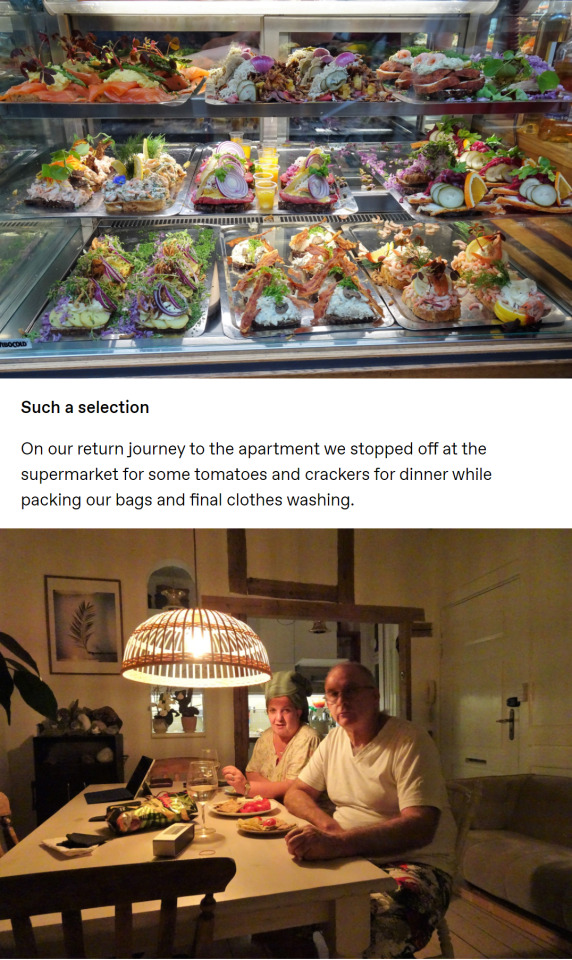
A bit of a letdown after lunch
Tomorrow we catch the S train to Stockholm. A high speed tilt train first class.
0 notes
Text
Crossing the Øresund
2/10/2019: Up early at six thirty to prepare for what we anticipated would be a good day. Having given up on the car hire, Øresund Bridge and the Øresund Strait ferry loop idea, we just took a nine thirty train straight up to Helsingør. The plan was to get there well before Kronborg opened and have a look around the town itself. Then after visiting the fortress, jump on the ferry and cross the water to Helsingborg. Helsingør is situated on the north coast of Sealand, straight opposite Swedish Helsingborg and separated by about four kilometres of the Øresund Strait.
We were welcomed upon leaving the apartment with sunny skies. Shane knew how to get the station but must have had the map upside down. Ended up doing an Anton Senna. Turned right when he should have turned left. Anyway, after walking for what must have seemed a couple of kilometres (it should have been a one kilometre walk), Jo was asked to check her phone. We ended up back tracking for ten minutes before we got to Copenhagen Central. At this stage, before knowing that the route was wrong, we were resigned to catching a cab to the station on Friday morning as the suit cases would have had their wheel gone by the time we got there.
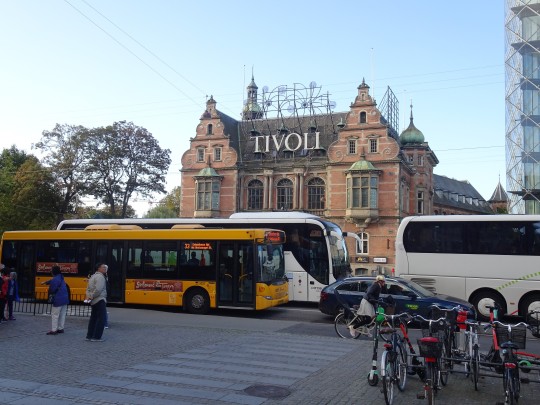
As close as we got. The joint was closed for winter
Once at the station we used automatic ticketing machine to purchase tickets, choosing one way to leave the option open for return via Malmö and back over the Øresund Bridge. We were winging it. The trip was a little rowdy as the train was full of kids on an excursion but luckily not sitting with us. They could have been our entertainment as there was not much to see on trip up. There were plenty of bushes to obscure any scenery that was around. By ten thirty and after a forty five minute trip we arrived at Helsingør.

The JFK with JFK at the end
The walk to Kronborg was nice. After walking the length of the mall, sort of window shopping where we may, a small square and road heading north lay before us. To our right were the large Ferries that we would be catching later on but for now we would be crossing the road and adjacent rail line to the large walkway on the wharf. We followed this around further, away from the ferries and started to encounter various boating types moored to the wharf. The first couple were old trawlers that looked that they were still in service except for the charter offers on the gang planks. The next was a large yacht, or ketch. Not sure which. At the end was a large modern building, The Culture Yard and Danish Maritime Museum where in the quay adjacent was a couple of small sailing dinghies. Beyond these was an old steamer lighthouse and another large sailing boat. Between them was a large artistic fish that reminded everyone of what was being pulled out of the sea or ocean every day. This area was immediately before the first of two bridges that led us to Kronsborg.
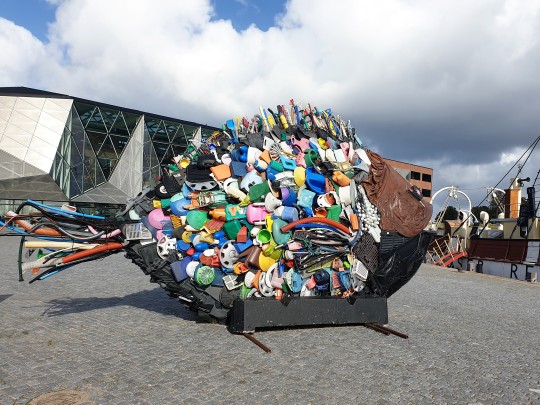
Save the world
Kronborg Castle was predated by a fortress called Krogen, built during the early fourteen hundreds by Eric of Pomerania. It was a fortress that along with Kärnan, a fortress across the straight built many years earlier controlled the narrow entrance to the Øresund and therefore the entrance to the Baltic Sea. With this Eric could charge Sound Dues, a toll that every ship had to pay if it wanted to sail on. Upon entering the strait, every non Danish ship had to stop at Helsingør and declare the value of their cargo to which they would pay a percentage. To stop captains from underestimating the value of their cargo, the Crown reserved the right to purchase that cargo. The other entry points to the Baltic Sea were also Danish controlled. Great Belt and Little Belt were reserved for Danish Ships only, transgressors had their ships confiscated or sunk.
Prior to Frederick II modernising the customs system, all ships paid the Sound Dues with an English coin named the "rose noble", representing the value of a good ox. During the lifetime of the Sound Dues, some three hundred and sixty years, the Danish King took some eighty six million rigsdaler off of almost two million ships.

The northern rampart and moat
Following a trail of ancient maps through the library showing Denmark's territorial dominance of the day, we ended up in the King's Chamber followed by the Queen's Chamber. Apparently royal relationships were arranged to maintain political dominance, stability and power. As such royal couples always had separate quarters as they may not have gotten on so well in private. This didn't seem to be the case with Frederik and Sophie (although he may have found himself in some hot water these days). During the first eleven years of his reign, Freddy concentrated on leading his armies to war. He then decided to settle down and find a wife and sort of settled on Margrethe of Pomerania. The hopeful princess travelled to Denmark with her entourage which included her daughter Sophie. He flicked the old girl and went for her daughter. He was thirty eight and she, fourteen. They had seven kids and lived happily ever after. Supposedly. The bedrooms were quite small so as they could be easily heated. Maybe body contact kept them warm. From there we moved to the Queen's Gallery.

Hugh banquet hall. Thrones down the other end
To the centre of the Great Ballroom was the Trumpeter's Tower, linking the floors together but as with the chapel, it was closed. We thought that we looked at all the floors but there was a ruckus above. We could here feet on the floor above the ballroom. When we went to go up there was a no entry sign but the kids coming down. It must have been put aside for the kids guided tour. Maybe the kids on the train this morning. We moved on.
Back at ground level was a room dedicated to the relationship between the castle and Shakespeare, after all Kronborg is known as Hamlet's castle. The action of the play about the Danish prince takes place in the Elsinore castle. Michael Cane, Vivien Leigh, Sir Laurence Olivier, Robert Shaw, Richard Burton, Christopher Plummer, Clare Bloom, Sir John Gielgud and many others including great Danish actors have performed in the castle.

Helsingør Station and the Øresund Strait ferry
Heading underground, we found ourselves in the casements, a network of dark corridors and rooms on several levels that served as soldier quarters during war. Reinforced bunkers beneath the bastions. During war the casements could hold up to one thousand men and enough provisions for up to four months if under siege. Those provisions were nothing like those privileged types above were afforded, these guys got a daily ration of porridge, bread and salted herring which was eaten from the barrel, mixed with brine. Since the water was too polluted they were given eight pints of beer a day.

Mørkeport's Ravelin (Dark Gate) and northern ramparts
Walking back around to the ferries, we went in the first ticket office that we came across. It wasn't the big one and only left on the hour. We were after the big ones so kept going. They were non stop but it was a bit confusing how to get there. The over head walkway to the ferries was straight above us but how to get to the ticket office was not so straight forward. There was a compound that would make entry easy but it was cordoned off and as such we entered the place next to the train station, caught the lift up a floor, paid and waited. Ten kronor each. They only opened the doors to the long glassed in gantry that connected us to the ferries a few minutes before boarding. We didn't wait long before we were on and heading out. By now it was pissing down. It started when we were back near the old fishing trawlers but wasn't as heavy. Now it was coming down in buckets.

What’s left of Kärnan. Just the tower really
We didn’t go up there just looked around. There wasn't much to look at. Everything was shut. A couple of streets further back was a mall where we could look around the shops but nothing special. Looking for a spot to rest was a priority but the first few cafés that were opened didn't look that inviting, one finally did so. Fahlmans Konditori looked inviting, the place looked pretty busy and had a good display of pastries. We ordered a couple with a tea and coffee and guess what, they didn't take cash. The Swedish kronor that we bought would be going back with us. Not as bad as the Yanks not far behind us where the old girl asked if they took US dollars. The food was good and the café interesting with historical pics of the area on the walls, trains boarding large ferries, iced over waters and such. Not enough to keep us there though so we headed back.
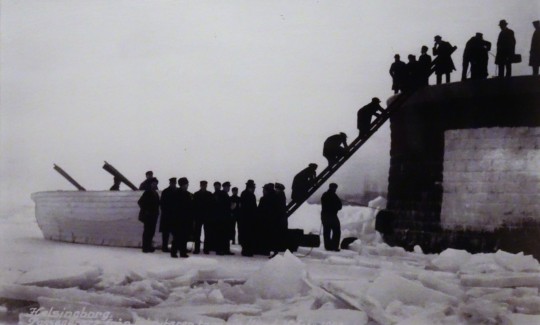
Fahlmans Konditori had some interesting photos on the wall
As luck would have it, it was with us again. When Shane went to pay for return ferry tickets (we chose to return the way we came due to uncertainty of schedules and the time of the day), he was told that their system was down and the trip was free. Not good for the company but there were bugger all people were on board anyway so who knows how much money they would make or lose each trip. The trucks and cars on board were a bit light on the first trip but numbers were up when they couldn’t charge money. We sat inside this time facing the rear. Once the ferry got underway Duty Free was on again. This time ten minutes of cigarettes followed by ten minutes of grog. To save some time on the way back we grabbed a couple of bottles of wine and a six pack on the boat. Cheaper than Copenhagen but similar to costs back home. By the time Shane got to be served the ferry was almost in, so close in fact that the checkout dude asked his superior if he could serve him. He got the nod, got his grog and headed to platform two at Helsingør for the return rail trip. We were back at Copenhagen Central pushing six thirty and using google to get back to the apartment. This would be the route we will take when leaving the city in a couple of days’ time.

The dodgems sitting idle at Tivoli
The rest of the night was a quiet on with a simple pasta dish and bed.
Tomorrow we'll head to Rosenborg.
0 notes
Text
There’s Something about Mary
1/10/2019: The alarm didn't go off this morning but we were up by eight. Not that we didn't hit snooze before anyway. After last night's discussion over travelling to Sweden for a day trip, and the advice given by Maryanne regarding costs with car hire and Øresund Bridge toll, we decided to spend our time more wisely. As such we looked around town again today and planned for a train trip later on. The plan for the day was to head down to where the Danish Royals live for a look around. Never know might run into Mary. Then, fill in the gaps on the way to the Little Mermaid.

Local taking his kids to school
Heading straight down Frederiksholms Kanal, past the museum and palace to the waterfront and turning left meant we couldn't miss anything. We rejoined Christians Brygge and under the Knippelsbro to just past Børskaj where we restocked.
Jo knew something was going on as there was a couple of vans of police going past outside of the museum accompanied by a helicopter hovering continually over the city. From Børskaj we could look back and see the spire of the Børsen and the dome of the palace surrounded by Danish flags.

Apparently it was the first day of parliament and Queen Margrethe II was on her way to open it
Not too long after we were in Nyhavn, the historic and flash eating spot. We were working our way up the shady side.
The Nyhavn canal was excavated between 1671 and 1673. Subsequently, the canal was developed as a port with bulwark and merchant houses either side, providing storerooms as well as accommodation for the merchants. There were a few early houses built but most were constructed in the seventeen hundreds. Sailing vessels unloaded their cargo for in the port, all bound for Kongens Nytorv in the city centre. By the eighteen hundreds the merchant houses were extended with the addition of an extra floor or two to accommodate apartments. The original buildings still dealt with the trades associated with the port including ships' stores, labour hire, hotels and "sailor joints". These shady places were lively, loud and frequented by sailors and ladies of every virtue. Hence we were on the "naughty side".

The "naughty side" of Nyhavn
As we got to the end and found the toilets, Jo noticed some ceremonial dudes marching down the street so we followed them to see what was going on. It was the changing of the guard which happened every day at Amalienborg, the Queen's winter residence. They marched down the centre of the road, stopping at traffic lights but holding up all traffic behind them. Once in the palace square, the ceremony continued with the replacement of every guard on the square in sequence. The guards on the left were the first followed by the guards protecting Prince Frederik and Mary directly next to the Queen's digs. The flag was up at Mary's joint which meant that they were home. She didn't stick her head out though, nothing. The whole process went on for quite a while with a few policemen keeping the crowd at bay.
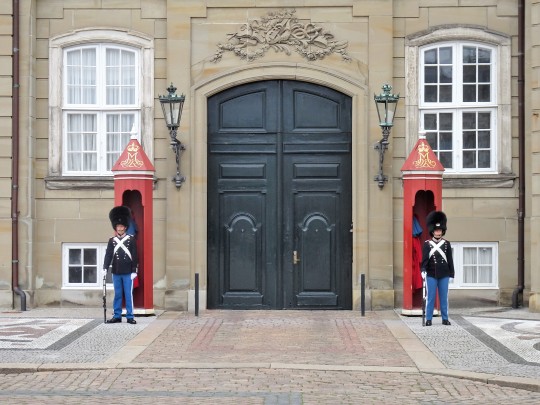
Guards looking after Fred and Mary
Following the royal kerfuffle we moved away from the crowd and onto the waterfront, sat near a coffee cart and ordered a couple of takeaways. They were very hot but good. The day wasn't too cold but it wasn't warm neither. Moving briefly from the water into a small park directly behind Mary's house, we sat down and pondered what she may be up to. Cleaning the palace up maybe, hanging out the washing? We suspected not.
Where do you reckon she was? It turned out that she was at Parliament with the queen. Who was at home then? Just the kids? It also just happens that the Parliamentary ceremony was at Christiansborg Palace, straight across from the museum and two hundred metres from our apartment. We must have crossed paths. Again, the 6 P's. Proper Preparation Prevents Piss Poor Performance.

Changing of the Guard
Next stop was the Kastelett but before that we encountered the most fantastic fountain of a woman flogging four bulls ploughing a paddock. Worked out it was a representation of the legendary Norse goddess Gafion, who ploughed the island of Zealand out of Sweden. Apparently, Gylfe, the Swedish king at the time for some stupid reason, granted Gefion as much land as she could plough in a day and night. She somehow changed her four sons into oxen and ploughed the shit out of the place. So much so that she raised the land enough to create the island of Zealand. Good story.
Next to the Gefionspringvandet was the only Anglican church in Denmark, Saint Alban's, consecrated in 1887. Prior to its construction the English speaking Christians had to worship in rented halls. After years of fundraising, the site where the church stands was obtained with the assistance of Princess Alexandra, daughter of King Christian IX and her husband Prince Edward, later King Edward VII of Britain.
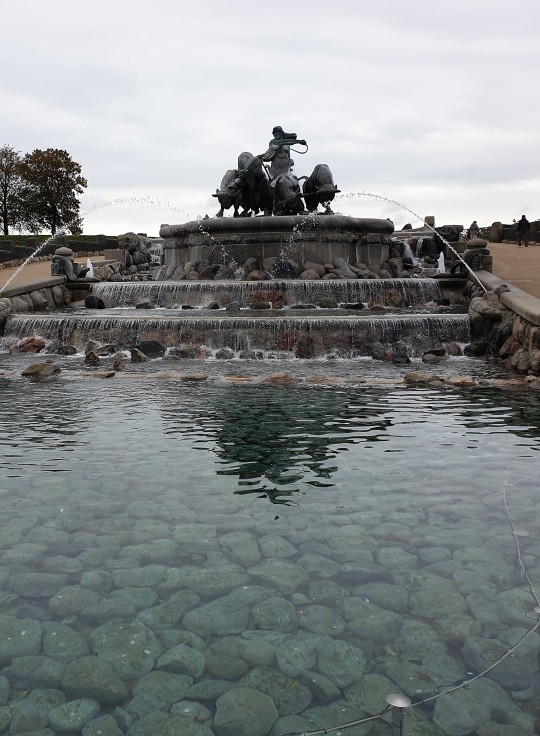
Gefionspringvandet

Saint Albans
Adjacent to the church was Kastelett, an historic fortress with ramparts surrounded by a moat and accessed by two timber bridges. Founded by King Christian IV during the sixteen hundreds, the citadel is one of the finest and best preserved fortifications around Northern Europe. In its day the fort was a critical link in the defence of Copenhagen from attack by sea. Walking around the ramparts gave us an appreciation of what the place must mean to the residents of the city. The grassy and shady earthen embankments that once formed the fort's protection must have been ten metres high, star shaped and linked by with five bastions each with cannons pointing outward. The barracks, painted red, once provided the accommodation for sailors, the yellow buildings their officers. Today, the buildings are still used as military barracks and also administration. Bar the buildings, the entire area is open to the public.
Maybe one of the citadels most famous prisoners (locally anyway) was a Danish/German doctor named Johan Friedrich Struensee. He was looking after the loony King Christian VII as his personal travelling physician. It wasn't long before he was bonking Queen Caroline Mathilde and this along with his unpopularity with his parliamentary /aristocratic colleagues led to an early demise at the fortress by way of beheading. Anyway, it was nice to walk around the area.

Canon pointing out from the western bastion
Not far beyond was the rather underwhelming statue of the Little Princess, still in top nick considering it is over one hundred years old. It was based on Hans Christian Andersen's fairy tale about a mermaid who gave up everything be united with a young handsome prince on land. Every morning and evening she swims to the surface from the bottom of the sea and perched on the rock, staring longingly towards the shore hoping to catch a glimpse of the prince.

After one hundred years you'd think she'd have given up. Marginally less boring than the Carl Marx Museum in Trier
It was time to head back to the apartment, via Nyhavn where we would seek a feed. We ended up ordering a couple of Smørrebrød since we knew they were traditional open sandwiches and looked scrumptious last night at TorvehallerneKBH. This time we walked down the sunny (or equally naughty) side of the place looking for tucker. The Hyttefadets Pub looked inviting with a good menu. Due to the coolness we sat near an outdoor heater and ordered a couple of sandwiches. Number 13, Ribbensteg med rødkål og hjemmelavet agurkesalat (Rib roast of pork served with red cabbage, and homemade pickled cucumber) and Number 14, Hønsesalat med sprødstegt bacon og asparges (Creamy poultry salad with bacon and asparagus on white bread), plus a couple of drinks. The food came out not as we expected. We expected them to look like the display last night but the came out as a meal, do it yourself type of thing. We ate it as a meal and had no complaints as to the quality. Very tasty.

Finger lickin' good
On the way back we stopped for some groceries and retired back to the apartment to cook some dinner and take it easy.
Tomorrow, the train trip.
1 note
·
View note
Text
Nationalmuseet and Food Tour
30/09/2019: The weather forecast is bleak. Atlantic Ocean storms pushing across Great Britain and across as for as Eastern Europe. Heavy rain and plunging temperatures expected.
We awoke this morning to the news that a forecast of Atlantic storms and associated cold front dropping temperatures by twenty degrees. Considering that it was not particularly warm anyway, it was something to look forward to.
We left after breakfast to look around, originally considering Rosenborg Castle, the adjacent King's Gardens and the Botanical Gardens. All next to each other and very close to the TorvehallerneKBH where our five thirty food tour would commence. The initial idea was to stay out all day so these areas would be ideal but due to the amount of walking and the uncertainty of the weather we stayed closer to the apartment. The final choice was the Nationalmuseet and palace over the road. Only a few hundred metres away.
Walking down Frederiksholms Kanal and turning right into Ny Vestergade led us straight to the front door of the Nationalmuseet, the largest museum of cultural history in Denmark. Ninety five kronor each got us inside. After hanging the coats in the cloak room we looked around the foyer and planned the move.

This wounded moose sank exhausted to the bottom of a lake at Täderup on Falster about 8,700 years ago
The Prehistoric displays dated from long ago until the year 1050AD centred around several "Ages" or periods. Among them were the Mesolithic and Neolithic Periods, the Bronze and Iron Ages, finishing off with the Age of the Vikings. Information told of the family unit, food, clothing, rituals and religion. Artefacts were wide and varied. The common thread were the bogs, it was all about bogs. No oxygen means no decay so a treasure trove of Danish history was spread about.
Everything was precious, everything was delicate. As such, everything was enclosed which made photography pretty challenging. Bone was the base material of choice in the first section, reindeer antler harpoon heads from almost 10,000 BC, fish hooks and etched objects of bone, antler and flint from the hunter-gatherer and fisher and pottery-making culture of the Kongemose and Ertebølle periods. The incised patterns on men’s weapons and the pendants of women and children were hunters’ attempts to ward off negative forces or "evil eyes" by the use of magic.

A woman and a child from Gøngehusvej. Red ochre had been sprinkled over the skeletons in the grave at Vedbæk in northern Zealand. The grave holds the remains of a woman around forty years old as well as a child of around three years. Two flint knives suggest that the child was a boy however the amulet beads from deer, boar, elk, bear and aurochs failed to protect him
Moving onto the Bronze Age section, we found plenty of examples of where the new process of alloying had dominated society, from battle implements as in swords, shields and helmets to the more cultured part of life with displays of musical instruments, ornaments and furnishings. One such example was three thousand year old horned helmets dug up in a peat-digging area of Brøns Mose at Viksø in Zealand. Another such item was a cast of a sun chariot, found when the former bog Trundholm Mose in northwestern Zealand was ploughed for the first time. Who knows what's down there? It’s a bit like the Italians and the Romans.

The lurs from Brudevælte Mose were found at the end of the eighteenth century. Ole Pedersen found "six curved brass horns" farming his bog. He later found the six mouth pieces meaning that six complete instruments had been discovered. The first and biggest lur find to date
The exit to the first section was through the exhibition of runestones, very interesting. Both male and female magnates of the period erected runestones. They commemorated the families, comrades, retainers and chieftains, showing continuity of clans and ensuring the rights of heirs. Originally painted brightly, the runestones were located in very public places, besides roads and fords.
Erecting runestones was a custom dating back to the eighth century. Most however were put up not long after Christianity was introduced around the year nine hundred and seventy. The advent of Christianity ensured the heathen burial customs were put paid to, the traditional custom of demonstrating power and wealth through grandiose burials was no more. The magnates needed to express their greatness and family unity through new thinking and did so through the messages on the runestones. The Sønder Kirkeby Runestone represents the oldest example of heathen society whist the Tårnborg stone, which includes Christian prayers is amongst the most recent.

Impressive old fireplaces were typical spread around the place
With Prehistory behind us we climbed the stairs to the next level, the Middle Ages and the Renaissance.
The Medieval spanned over five hundred years from the end of the Prehistoric period, around the year one thousand when the Roman Catholic Church and the Pope controlled everything until fifteen thirty six when the Lutheran Reformation. Medieval art was widespread as most were illiterate, the images and symbols visualised society's cohesion and one's place in society. Most art was owned by the church, royals, noblemen and rich people.
The Renaissance in Denmark meant something different than that of the original Italian context. Unlike the rest of Europe which had lost interest in the antique culture during the middle ages, the Renaissance to the Danes were to a large extent a product of the Middle Ages. Exploration and travel meant the advances of the world were introduced with private collections established amassing rare, costly and unusual objects including clocks and scientific instruments. And drinking horns.
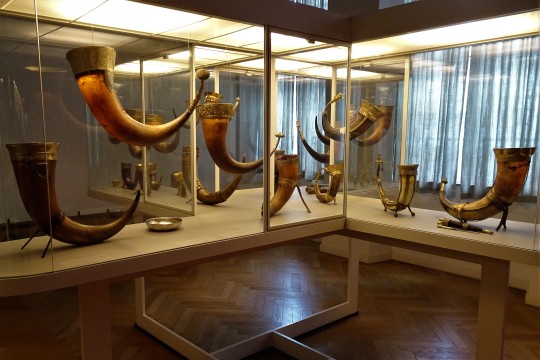
Not being intended to be put on the table, large drinking horns were intended to be passed from hand to hand until empty during festive occasions. They were popular in the guilds of Danish towns and cities, skilled goldsmiths making them from Southern European cattle.
Original antique furniture adorned the corridors throughout the palace. Painting of royals and nobles adorned the walls. In the display cases were religious statuettes and trinkets, the usual ivory Adoration of the Magi, processional crosses and swanky looking chalices, all very nice but none as nice as the impressive bejewelled reliquary, with religious motifs all over. Equally as impressive was the Book of Horne, an evangelistary manuscript from the early thirteen hundreds or older and Christien I's take it with you altar.

Winged altars in the Medieval Gallery
The next move was up again. Stories of Denmark from 1660 up until 2000.
Danish way of life from the time of Absolute Monarchy to modernity. We thought we were all over the old Denmark by now but apparently not.
There was some old stuff but not much. Representations of old stores and wealthy merchant's living rooms, women's clothing from the various regions, both near and far proved worth a look. The toys proved worthwhile, particularly the dolls and doll house display. Not only were the doll houses wide and varied but one could climb in behind and look at the furnishings and such within each room. Very interesting.

Trying to tell him something
We headed back to the apartment to prepare for the evening. The morning dedicated to historical culture, the evening dedicated to foodie culture.
The food tour started at 5.30 at a place called TorvehallerneKBH, a twin marque type of establishment that was full of gourmet food stalls and such. We were to meet our guide at the back but the instructions weren't clear and the meeting was disjointed. We stood around for a while wondering who we were to meet and who were the others in our group. When we thought it was going to fall flat, out of nowhere came our guide. With her came three others, older than us and from, you guessed it, South Australia. Two brothers and one wife. We waited for a while longer for one more person who never fronted. Not until ten minutes later when the guides phone rang and subsequently, a young American woman turned up.
We were off and running, the first stop being Arla Unika. While looking around it was explained to us that the stall holders are all selected and given a twelve month contract which can be renewed. Outside stalls were given a three month contract. Arla Unika specialised in dairy products, particularly cheeses and butter accompanied by fruit wines and beer. Our first sample got the show off to a good start, three cheeses, a tomato marmalade with a rhubarb wine or liqueur to go with it.
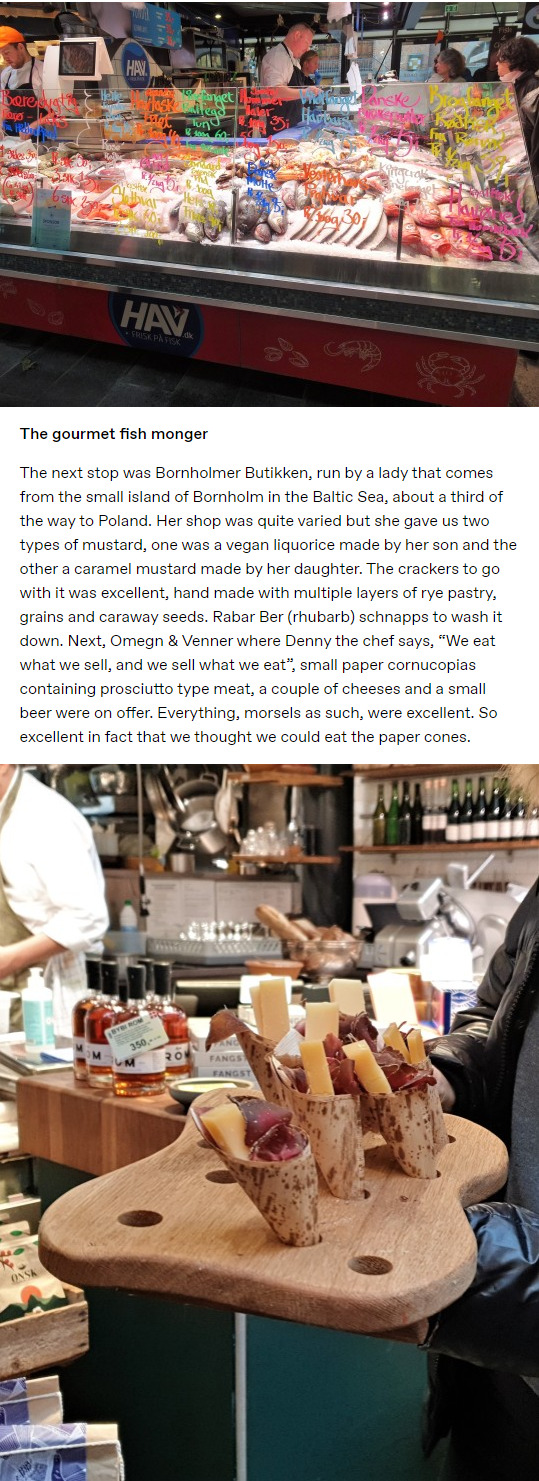
The paper cones looked the tastiest
We then changed buildings. This introduced us to Asa, handing out samples of organic spices and chai tea then outside in the cold for a couple of honey samples. The same species of bees and the same collectors but the taste of the two samples were quite different, one from the botanical gardens and flowers galore, the other from outside of town in the forest. Back inside to Summerbird Organic where we indulged in homemade chocolate with marshmallow called Flødebolle, a traditional gift for those coming home for birthdays, Christmas etc. This was the only place that we purchased anything. Chocolates for later. Everything was excellent, everything was very expensive. That was it, off to the restaurant for some real tucker.
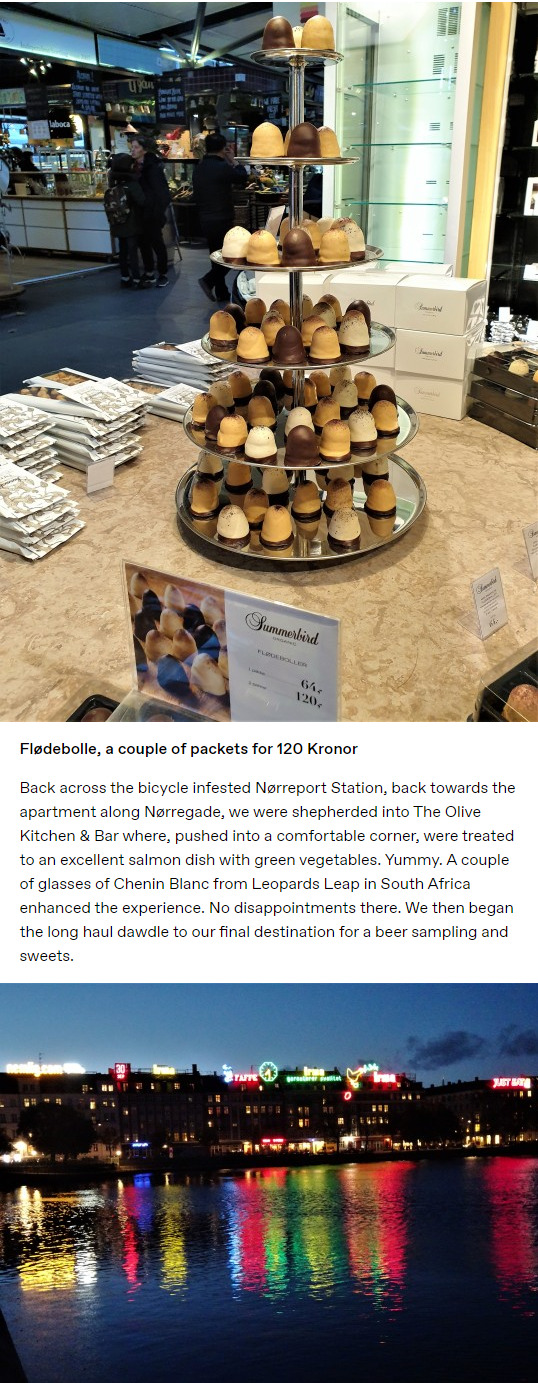
Our destination, a beer connoisseur's cafe & restaurant serving hearty cuisine matched with Nørrebro brewery ales
Our final stop for the night was back the way we came, past TorvehallerneKBH and down Frederiksborggade. Nørrebro Bryghus was across the Peblinge So, one of Copenhagen's three lakes bordering the city's western side. Although it was so shallow we probably could have walked across it we took the Dronning Louises Bro (Queen Louise Bridge) and took the walking path to the right immediately afterward. Our guide told us that it was the world’s busiest bicycle street with tens of thousands of two wheeled traffic traversing it daily. Fun fact. A couple of corners later we were at our destination and seated.
Only a chocolate desert was to go but luckily three beer samples come with it. They were typical craft beers, ranging from ordinary at best to quite nice (in a small dose). Equally lucky was that most didn't like the beer so Shane and old mate from South Australia benefited well from the offering. Afterwards we thanked our guide for a great night, said our farewells and headed back.

“I drink Champagne when I'm happy and when I'm sad. Sometimes I drink it when I'm alone. When I have company I consider it obligatory. I trifle with it if I'm not hungry and drink it when I am. Otherwise, I never touch it -- unless I'm thirsty.” ― Lily Bollinger House of Bollinger Champagne
Tomorrow we'll look around a bit more.
0 notes